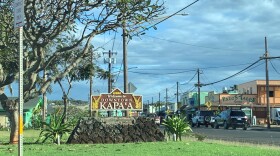O‘ahu's popular Mānoa Falls Trail reopened Sunday after being closed for improvements since July 2019—just in time for National Trails Day. With tourists streaming back to the area, The Conversation talked to State Parks Administrator Curt Cottrell about regenerative tourism and how Hawai‘i can manage its recreational hotspots.
The trail was originally closed so the state Department of Land and Natural Resources could install a rockfall hazard mitigation fence next to the 150-foot falls. With the trail closed for the fence installation, Nā Ala Hele also installed some long overdue trail safety improvements, the DLNR said.
Improvements included widening the trail for two-way traffic, trail bed resurfacing, new steps, and erosion and water runoff control measures, according to the DLNR. Before the pandemic, Nā Ala Hele said Mānoa Falls attracted 700 to 1,000 people daily.
A recent survey by the University of Hawai‘i Economic Research Organization found that residents want better management of visitors across the state. The report also emphasized there is a strong consensus among residents that the state should play a bigger role in managing tourism.

"You know I hate to overuse this word, but the paradigm shift that we're dealing with is, I think, unprecedented in this state that has been so completely reliant on tourism," Cottrell said. "All of our local residents got a break from the crushing saturation load of the tourism industry."
Speaking on tourism management among other things, here are some excerpts from Cottrell's interview, edited for length and clarity.
On tourism at Mānoa Falls
COTTRELL: Mānoa Falls is going to be hugely impacted because there is no filtering system at Mānoa Falls. The only limitation is the parking. We know the visitor will just keep parking farther away in order to get to their intended recreational spot. Because of the ease of the hike and the waterfall at the end, I suspect that the Mānoa community is going to see the impacts that Hāna, Wainiha, Hāʻena and other locations are experiencing.

On the quick resurgence of U.S. mainland visitors
COTTRELL: Here's the interesting thing that we didn't expect. I think Hawai‘i was kind of caught with our pants down around our ankles a little bit, in terms of we couldn't have anticipated this instant and quick resurgence. Hawai‘i has become a very attractive venue: we're safe, we're still reasonably priced. And we're getting such a surge of mainland visitors, as opposed to the Asian market that hasn't [re]booted up yet with the buses and the cruise ships and all that.
But here's the thing, and I hate to throw my fellow Americans under the bus, but U.S. mainland visitors don't have the same degree of discipline or honoring certain restrictions or protocols that maybe other visitors have. And so in addition to crushing numbers of American visitors coming in, we're getting a lot of behavioral issues that we're just not prepared for: people going out of bounds, stopping in the middle of the road on the Hāna Highway to take photographs... creating that part of tourism that now we've experienced the absence of.
Now that it's come back in such a big way, government is scrambling to come up with methods to try to control that flow and to start to learn how to do regenerative tourism and minimize impacts to communities. But it's hard. It's like we're rebuilding the airplane and flying it at the same time.
On how to balance experiences for tourists versus residents
COTTRELL: What we're all looking at is: How do we pay for these reservation and fee systems? And I think because Hawai‘i has been so far behind the curve of charging for recreational spaces, we're catching up to that. Now, we did the state park fee increase during the pandemic, and we're now charging some of the almost highest prices in the nation for some of our features. I think for trails, we hate to look at a system where people have to pay to hike. It's particularly tricky in a situation where you have cultural and endemic access rights.
But if we continue just to really focus on the visitors as the intended recipient of reservations and fees, I think that'll be the additional funding mechanisms we got to put into place to start managing both the technology on reservations and these impacts. But at the end of the day, those planes are going to keep coming in and as long as there are hotel rooms and aircraft seats, we can set up as many defenses at the various destinations as possible, but it will have unintended consequences as they search for other destinations.
On the financial gain of charging entry and parking fees
COTTRELL: A conservative estimate, by the end of the year, our state parks will generate a $4 million to $5 million surplus in our special fund based on our fee increase and patronage. And we're going to need to go to the Legislature next year to get the authority to spend it because they keep tabs on our spending ceiling. So even though we're generating way more funds than we ever have, until we have that authority to spend it we can't convert those funds into the tools we need to deploy on the ground to help improve quality and manage visitors within the park units.
We're short [on staff]. We lost seven positions that were cut because of the anticipation of a flat economy for several years. We have six positions that are not funded, so that's 13 park workers statewide that I don't have access to, in addition to the current hiring freeze for some other positions that we could use right now on the ground dealing with the impacts of the visitor. So our tools in our tool chest have been slightly trimmed as well.
This story aired on The Conversation on June 7, 2021.





